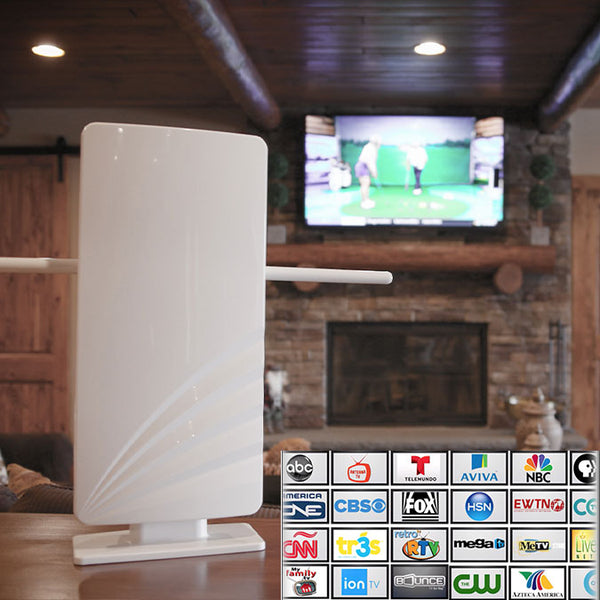Television antennas have come a long way since their inception. From the humble rabbit ears perched atop old television sets to sleek, high-tech television antennas capable of capturing digital signals, their evolution mirrors the advancements in broadcasting technology.
### Historical Overview:
Television antennas made their debut alongside the rise of television broadcasting in the mid-20th century. Initially, antennas were simple devices designed to capture over-the-air signals transmitted by broadcasting stations. These early antennas, often referred to as "rabbit ears" due to their distinctive shape, were typically mounted on top of televisions and adjusted manually to optimize signal reception.
### Analog to Digital Transition:
The transition from analog to digital broadcasting marked a significant milestone in the evolution of TV antennas. Analog signals, susceptible to interference and distortion, gave way to digital signals, which offered superior clarity and reliability. This transition necessitated the development of new antenna designs capable of capturing digital signals more effectively.
### Types of TV Antennas:
#### 1. Indoor Antennas:
Indoor antennas are compact, portable devices designed for use inside homes or apartments. They are typically mounted near a television set and are ideal for urban areas with strong signal coverage. Indoor antennas come in various designs, including flat-panel antennas, loop antennas, and dipole antennas.
#### 2. Outdoor Antennas:
Outdoor antennas are larger, more robust devices designed for outdoor installation. They are mounted on rooftops or poles and offer superior signal reception compared to indoor antennas. Outdoor antennas come in different configurations, such as Yagi antennas, log-periodic antennas, and phased-array antennas.
#### 3. Directional vs. Omni-directional Antennas:
Directional antennas are designed to capture signals from a specific direction, making them ideal for areas with distant or weak broadcasting stations. Omni-directional antennas, on the other hand, capture signals from all directions, making them suitable for locations with multiple broadcasting stations spread across different directions.
### Installation and Setup:
Proper installation is crucial for maximizing the performance of a TV antenna. Factors such as antenna type, location, and orientation play a significant role in signal reception. Here are some key steps to consider when installing a TV antenna:
#### 1. Choose the Right Location:
Select a location for the antenna that offers a clear line of sight to broadcasting towers. Avoid placing the antenna near large obstacles such as buildings or trees, as these can obstruct signal reception.
#### 2. Mount the Antenna:
Securely mount the antenna using appropriate hardware, such as brackets or masts. Outdoor antennas should be mounted as high as possible to minimize obstructions and maximize signal strength.
#### 3. Orient the Antenna:
Adjust the orientation of the antenna to align it with the broadcasting towers. Use a compass or smartphone app to determine the direction of nearby towers and adjust the antenna accordingly.
#### 4. Scan for Channels:
Once the antenna is installed, scan for channels using the television's tuner or a digital converter box. This process will detect all available channels and program them into the television's memory.
### Troubleshooting Common Issues:
Despite proper installation, TV antennas may encounter various issues that affect signal reception. Here are some common problems and troubleshooting tips:
#### 1. Poor Signal Quality:
If the signal quality is poor, try adjusting the orientation of the antenna to improve signal strength. You may also consider upgrading to a more powerful antenna or installing a signal amplifier to boost weak signals.
#### 2. Interference:
Interference from nearby electronic devices or structures can disrupt signal reception. To minimize interference, relocate the antenna away from sources of electromagnetic interference and ensure proper grounding.
#### 3. Signal Dropouts:
Signal dropouts may occur due to atmospheric conditions or signal obstructions. To mitigate dropouts, periodically rescan for channels to update signal information and adjust the antenna as needed.
#### 4. Multipath Interference:
Multipath interference occurs when signals bounce off objects and arrive at the antenna out of phase, causing ghosting or distortion. To reduce multipath interference, use a directional antenna and adjust its position to minimize signal reflections.
### The Future of TV Antennas:
In an era dominated by digital streaming services and on-demand content, the relevance of TV antennas may seem diminished. However, TV antennas continue to play a vital role in providing access to local broadcast channels and emergency alerts, especially in areas with limited internet access or during emergencies.
Advancements in antenna technology, such as the development of smart antennas with built-in signal processing capabilities, promise to further improve signal reception and enhance the viewing experience for consumers.
In conclusion, TV antennas have evolved significantly over the years, adapting to changes in broadcasting technology and consumer preferences. Whether it's capturing over-the-air signals or complementing digital streaming services, TV antennas remain a versatile and essential component of the modern television ecosystem.


You must be logged in to post a comment.